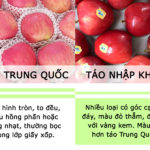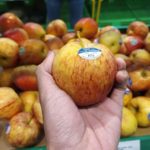As disposable incomes rise and consumers become more discerning about food safety, many are turning to imported fruits, including apples, to meet their daily needs. Here is a guide to some of the most popular imported apple varieties:
1. Red Delicious Apple
The Red Delicious apple was introduced to the market in 1874, originating from Peru, Iowa. While its exact origins are unknown, it was discovered as a chance seedling on Jesse Hiatt’s farm and was initially known as Hawkeye.
Red Delicious apples are characterized by their heart shape and bright red skin, sometimes with stripes. They are renowned for their crisp texture and sweet flavor, making them an ideal choice for salads.
This variety is commonly used for desserts, snacks, or as a refreshing ingredient in salads.
 Red Delicious Apple
Red Delicious Apple
2. Golden Delicious Apple
The Golden Delicious apple made its debut in 1914 and is believed to have originated from the Golden Reinette and Grimes Golden varieties. While its exact origins are unknown, it is thought to have come from these regions.
Golden Delicious apples are a chef’s favorite, as their sweet and mild flavor, coupled with a crisp texture and soft, golden skin, make them a perfect choice for any recipe.
This variety is commonly used for snacks, salads, baked goods, beverages, apple pies, sauces, and frozen desserts.

3. Gala Apple
The Gala apple was introduced in 1965 and has its origins in New Zealand. It is a cross between Orange Kidd and Golden Delicious apples, resulting in a unique variety.
Gala apples are known for their sweet and fragrant flavor, with distinctive pink-orange stripes on a yellow background. They are an excellent choice for salads, apple pies, and sauces.

4. Fuji Apple
The Fuji apple was introduced in 1962 and originated in Japan. It is a cross between Red Delicious and Ralls Janet apples, combining the best of both varieties.
Fuji apples are medium-sized and have a round, slightly angular shape. They typically weigh 200-250 grams each and boast firm, juicy, and sweet flesh. Their skin is red, and they have a smooth and glossy appearance, making them visually appealing.
This variety is commonly used for snacks, salads, baked goods, beverages, apple pies, sauces, and frozen desserts.

5. Granny Smith Apple
The Granny Smith apple was introduced in 1868 and has its roots in Australia. It is believed to have descended from French Crabapples cultivated by Maria Ann Smith, an Australian grandmother, and namesake of this variety.
Granny Smith apples are on the smaller side, with an average of 5-6 apples per kilogram. Their skin has a light pink blush over a green background, and the flesh is white, firm, and crisp, delivering a tangy flavor.
This variety is suitable for snacks, salads, baked goods, beverages, apple pies, sauces, and frozen desserts.

6. Honeycrisp Apple
The Honeycrisp apple was introduced in 1991 and originated at the University of Minnesota, Minneapolis-St. Paul. It is a cross between Keepsake and an unknown variety, creating a unique and delicious apple.
Honeycrisp apples live up to their name, offering a crisp, sweet, and juicy experience. Their bright red skin with green speckles and a blend of sweet and slightly tangy flavors make them a versatile ingredient in various recipes.
This variety is commonly used for snacks, salads, baked goods, beverages, apple pies, and sauces.

7. Cripps Pink Apple
The Cripps Pink apple was introduced in 1985 and originated in Australia. It is a cross between Golden Delicious and Lady Williams apples, resulting in a unique and flavorful variety.
Cripps Pink apples are beloved by snack producers and bakers alike for their sweet and sour flavor and crisp flesh. Their vibrant pink skin gives them a distinctive look and their namesake.
This variety is commonly used for snacks, salads, baked goods, beverages, apple pies, sauces, and frozen desserts.

8. Braeburn Apple
The Braeburn apple was introduced in 1952 and originated in New Zealand. While its exact origins are uncertain, it is believed to be a cross between Lady Hamilton and Granny Smith apples, discovered as a chance seedling.
Braeburn apples offer an intense and irresistible flavor. This crisp apple variety provides a sweet and sour taste with a rich, sweet aroma. Their skin color ranges from orange to red and golden yellow, making them visually appealing as well.
This variety is commonly used for snacks, salads, baked goods, beverages, apple pies, sauces, and frozen desserts.

9. Rockit Apple
The Rockit apple is a premium variety imported from France. These apples are small, with a bright red and yellow skin, and have a firm, compact shape.
Rockit apples are highly nutritious and packed with juice. They offer a sweet and crisp flavor with a unique aroma, making them a delightful snack or ingredient.
 Rockit Apple
Rockit Apple
10. Ambrosia Apple
The Ambrosia apple was first discovered in Canada and is now grown in various temperate regions, including Canada, the USA, Chile, and New Zealand. The harvest season typically starts in September or early October, and these apples boast a bright red skin over a golden yellow background.
Each Ambrosia apple is large, with an average of 4 apples per kilogram. They have a crisp texture, natural sweetness, and high water content, making them extremely popular in Vietnam and beyond.
 Ambrosia Apple
Ambrosia Apple
These are just a few of the most popular imported apple varieties. We hope this guide helps you select the perfect apple for your culinary creations and daily needs.
Be sure to check out our blog section for more interesting articles and insights!




































